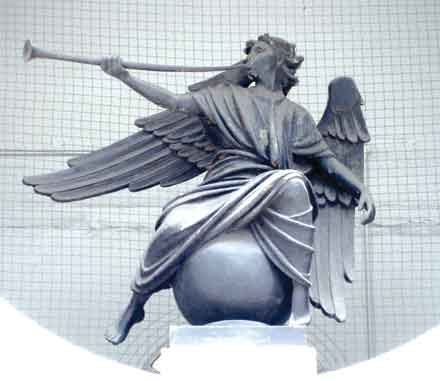Public Sculpture in Britain A History

Public Sculpture in Britain A History
Public Sculpture in Britain A History
Geoffrey Archer
416 pp, 300 col illus, April 2013
ISBN: 978-1-872914-40-4 £30.00
Ch 1, 'Monarchs' is about the foremost subject for sculpture, beginning with the Eleanor Crosses in medieval times and moving on to the iconoclasm of the first Elizabethan period and the Interegnum. Many years later there were quantities of statues of Queen Victoria and it seemed as if Britain's cities - Glasgow, Leeds, Manchester, Winchester- competed for monumental grandeur by the finest of sculptors such as Francis Chantrey, John Steell, Alfred Gilbert and Thomas Brock. There were also retrospective figures of Richard I and Queen Boudicca. An examination of the Victoria Memorial follows an assessment of the even grander memorial to Prince Albert. Accompanying pictures show equestrian statues by Michael Rysbrack, Carlo Marochetti and others, the most recent being a 2003 equestrian statue of Queen Elizabeth II by Philip Jackson.
Ch 2, 'Military Heroes' begins with delays and disappointments in connection with London's big sculptural programs for Admiral Lord Nelson at Trafalgar Square and Wyatt's equestrian statue of the Duke of Wellington. It progresses to subjects involved in Empire wars, such as Field Marshal Roberts whose statue by Harry Bates was considered by G.F. Watts as, 'Without question the finest equestrian statue of modern times'. Late 20th century statues of Field Marshals Slim and Montgomery, Air Marshal Dowding and others are mentioned along with sculptors such as Ivor Roberts-Jones, Faith Winter, Vivienne Mallock and Les Johnson.
Ch 3, 'The Great and the Good' recounts 'statuemania' from 1850 onwards, with memorials to philanthropists, inventors, historical leaders, writers and even artists, prompting the question, 'Who deserves to be be remembered with a statue?'' In fact not all memorials featured statues of the subject, as with Eros at the memorial fountain of the 7th Earl of Shaftesbury. There were other memorials by proxy, of 'haracters rather than authors, among them Peter Pan and Sherlock Holmes. In one case, Rima, a character in Green Mansions was carved by Jacob Epstein in a 1925 memorial to the writer, W.H. Hudson. A row about modern style exploded. The Morning Post was mischievous: ''...were not the English a tolerant people, it would have long ago been broken into pieces'. Today's equivalent of 'the Great and the Good' have been referred to as 'celebrity bronzes' with musicians, comedians and footballers depicted (John Lennon, Eric Morecambe, Denis Law). A few recent figurative sculptors are named: Gerald Laing, Elisabeth Frink, James Butler and Philip Jackson.
Ch 4, 'War Memorials' begins with 19th century war examples, most significant of which was the Guards Crimean War Memorial in London, the first to commemorate unnamed rank and file servicemen. But by far the majority of memorials were erected in the aftermath of World War One. Geoff Archer is very much 'at home' here, as author of The Glorious Dead in which he researched hundreds of memorial sculptures. With allegorical figures of Truth, Peace and Victory standing over anguished soldiers, they represent the largest input of public sculpture Britain has ever known, and proclaim one role of sculpture in mediating public grief. The chapter closes with contemporary war memorials, in particular Ian Rank-Broadley's figures at the Armed Services Memorial.
Ch 5, 'Architectural Sculpture' is not solely an account of emblems and statues decorating buildings. It delves into art education and cites the emergence of a respected artisan class of sculptor, distinct from the mid-Victorian high-art elitist practitioners. Before long we are back in the fray with responses to Epstein's figures on the frontage of the British Medical Association building. Tempers flared with other sculptures at the London Underground Building, the BBC and the Bank of England, yet similar works would hardly raise an eyebrow today. Henry Moore, Barbara Hepworth are discussed as well as less known sculptors, Peter Peri and William Mitchell.
Ch 6, 'Sculpture in Public' plots the promotion of modernism in the 2nd half of the 20th century, with sculpture in open air exhibitions in Battersea Park and the Festival of Britain. There were links to earlier precedents of drinking fountains and hundreds of sculptures at the Crystal Palace at Sydenham. The 1952 competition for a monument to the 'Unknown Political Prisoner', and the placing of contemporary works in schools, universities and New Towns are examined. Again, controversy loomed at every step, from Victor Pasmore's problems with his Apollo Pavilion at Peterlee to the antagonism towards the Stuyvesant City Sculpture Project. At the centre of 'Sculpture in Public' is the question: who is it for?
Ch 7, 'Public Art' looks at developments towards the end of the 20th century and into the 21st, including the growth of sculpture parks, the exhibition of sculpture in garden festivals and, most importantly, the beginnings of a change of attitude in some sculptors to work with and for the public. The promotion of public sculpture in urban redevelopment schemes and the rising popularity of 'landmark sculptures' (not least the 'Angel of the North' by Antony Gormley) are noted, along with the works of recent and contemporary sculptors including Jaume Plensa, Eduardo Paolozzi, David Mach and Anish Kapoor. Tempers are tested with temporary projects such as Rachel Whiteread's 'House' and the 'Fourth plinth' program. Yet the history of Britain's public sculpture closes on a high note, literally and metaphorically, with ever-larger sculptures planned, and with optimism too, as if lessons have been learned and people in Britain are looking forward to future public sculpture.
Rights: ©2013 Geoff Archer/ Frontier Publishing.
________________________________________________________
Email
contact@frontierpublishing